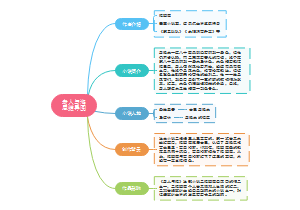导图社区 英语句子分类
- 199
- 15
- 5
- 举报
英语句子分类
整理了高中英语句子的分类,包括了句子汇总,简单句,并列句,复合句等内容,学习英语的高中同学们可以通过这篇学习框架,进行学习了解。
编辑于2021-06-13 19:29:04- 英语教育
- 英语句子
- 相似推荐
- 大纲
句 子
简单句
1、主语+不及物动词 She came. / My head aches.
2、主语十及物动词十宾语 She likes English.
3、主语+系动词+表语 She is happy.
4、主语+双宾动词十间接宾语+直接宾语 She gave John a book . She bought a book for me.
5、主语十宾补动词+宾语+宾语补足语 She makes her mother angry. The teacher asked me to read thepassage.
6、There +be There lies a book on the desk.
复合句2
定语从句
定语从句的基本结构为:先行词+关系代词或关系副词+从句本身
1、关系代词 在定语从句中,能作关系代词的有which、that、who/whom。 (1)which/that指物 eg:The book which/that you borrowed me yesterday is interesting. (2)who/that指人 eg:He is the man who/that lives next door. 注意:关系代词在从句中作宾语时,which/that保持不变,who变为whom。 eg:We wondered whom the book was about.
2、关系副词 在定语从句中,能作关系副词的有why(表原因)、where(表地点)、when(表时间) eg:This is the reason why I was late this morning. This is the town where he was born. Tom got married in 2000 when he was 24 years old.
限制性定语从句和非限制性定语从句区别
1、结构上的区别 限制性定语从句不用逗号与主句隔开 例:I have a sister who is a doctor. 非限制性定语从句需使用逗号和主句隔开。 例:I have a sister, who is a doctor.
2、意义及功能上的区别 限制性定语从句修饰和限制先行词,明确先行词内容,是先行词不可缺少的定语。如果删去,会影响主句意义的完整 非限制性定语从句是对先行词的附加补充说明。如果删去,不会影响主句意义的完整。
3、关系词使用上的区别 ①在限制性定语从句中,当关系词做宾语时可以省略。但在非限制性定语从句中,关系词是不可省略的。 ②非限制性定语从句中不能使用关系代词that或why ③、在限制性定语从句中有时可用who代替whom,但是在非限制性定语从句中不可以用who代替whom ④、在非限制性定语从句中,“介词+关系代词”结构前可以使用all、both、most、some等词,与of which/whom搭配。 ⑤、as引导非限制性定语从句
状语从句
(一)时间状语从句 表示时间的状语从句可由when, as, while, whenever, after, before, till (until), since, once, as soon as (或the moment ), by the time, no sooner … than, hardly (scarcely) … when, every time等引导。 e.g. When I came into the office, the teachers were having a meeting.
(二)原因状语从句 原因状语从句是表示原因或理由的,引导这类从句的最常用的连词是because, since, as , now that(既然)等,for 表示因果关系时(它引导的不是从句)为并列连词,语气不如because强。 e.g. He is disappointed because he didn't get the position.
(三)地点状语从句 引导地点状语从句的连词是where 和wherever等。 e.g. Sit wherever you like.(二)原因状语从句 原因状语从句是表示原因或理由的,引导这类从句的最常用的连词是because, since, as , now that(既然)等,for 表示因果关系时(它引导的不是从句)为并列连词,语气不如because强。 e.g. He is disappointed because he didn't get the position.
(四)目的状语从句 引导目的状语从句最常用的词(组)是so, so that(从句谓语常有情态动词), in order that, in case(以防,以免)等。 e.g. Speak clearly, so that they may understand you.
(五)结果状语从句 结果状语从句是表示事态结果的从句,通常主句是原因,从句是结果。由so that (从句谓语一般没有情态动词), so … that, such … that等引导。 e.g. She was ill, so that she didn’t attend the meeting.
根据翻译句子来确定
复合句1
主语从句
1. 以what等连接代词引导的主语从句 What you need is more practice. 同类的连接代词还有:What, who, whom, whose, which, whatever, whoever, whichever
2. 以that, whether从属连词引导的主语从句 It was strange that he had made a mistake.
3、连接代词who, whom, whose, what, which 连接副词when, where, why, how,起连接作用,作句子成分 The teacher asked the new students which class he was in.
4. 以when,where,why,how等连接副词引导的主语从句 When they will come hasn't been made public.
5. 虚拟语气:主语从句 形容词为necessary, important, impossible, strange, natural, essential时,在“It + be + 形容词或过去分词 + 主语从句”中,主语从句要虚拟。 It is necessary that the problem (should) be discussed at once.
宾语从句
关联词
1、 连词that,只起连接作用,在从句中不作句子成分 He knew (that) he should work hard.
2、连词if 、whether,在从句中不作句子成分 He asked me whether or not I was coming.
一般情况下,if 和whether可以互换,但以下3种情况只能用whether: ①在不定式前:Whether to go there or not hasn’t been decided. ②在介词前:It depends on(依靠) whether it is going to rain. ③与or not连用:They are talking about whether to go there or not.
宾语从句语序
宾语从句的语序是陈述语序,即“连接词+主语+谓语+其它成分”。特别强调:它的主语和谓语的语序是陈述语序,而不是疑问句的倒装结构。 Can you tell me who(m) do we have to see?(╳); Can you tell me who(m) we have to see?( √)
表语从句
①由从属连词that,whether,as though(if)引导的表语从句。 that在引导表语从句时无词义,而whether意为、“是否”。这时主句的主语常常是些抽象名词,如question(问题),trouble(麻烦),problem(问题),result(结果),chance(可能性),suggestion(建议),idea(想法),reason(理由)等。表语从句对主句主语进行说明、解释,使主语的内容具体化。 e.g:The trouble is (that) she has lost his money.
②由关系代词引导的表语从句。 关系代词who, what, which, whom, whose, whatever, whoever, whomever, whichever等引导表语从句,在句中作主语、宾语、表语,关系代词不能省略。 e.g:The question is which of us should go. The problem was who could do the work. That's what he is worrying about.
③关系副词when, where, why, how, however, whenever, wherever等。 (根据句意决定)
③由连词because,as if/as though等引导的表语从句 It looked as if it was going to snow. That's because we never thought of it.
同位语从句
同位语从句用来对其前面的抽象名词进行解释说明,被解释说明的词和同位语在逻辑上是主表关系
同位语从句的先行词通常为answer, hope, fact, truth, belief, news, idea, promise, information, conclusion, order, suggestion, problem, question, thought, report, belief, decision, doubt, opinion, theory等抽象名词。
并列句
并列连词
①常用并列连词(coordinating,conjunctions ) ②平行并列连词: and, both..and, not only..but also, neither..nor, and then ③转折并列连词: but, however, while, yet ④因果并列连词: for, so ⑤选择并列连词: or, either..or, neither.. nor









